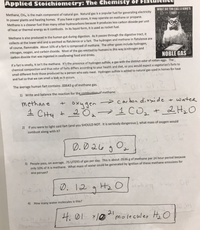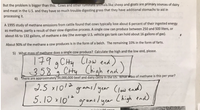
Chemistry
10th Edition
ISBN: 9781305957404
Author: Steven S. Zumdahl, Susan A. Zumdahl, Donald J. DeCoste
Publisher: Cengage Learning
expand_more
expand_more
format_list_bulleted
Concept explainers
Question
#6, the answer is already there. Just need to learn how to do the work.
included the entire worksheet incase of other needed values for the equation.

Transcribed Image Text:Applied Stoichiometry: The Chemisty öf
WHAT DO YOU CALL A KING'S
FART (
Methane, CHa, is the main component of natural gas. Natural gas is a popular fuel for generating electricity
in power plants and heating homes. If you have a gas stove, it may operate on methane or propane.
Methane is a cleaner fuel than many other hydrocarbons because it produces less carbon dioxide per unit
of heat or thermal energy as it combusts. In its liquid form, it is used as rocket fuel.
Methane is also produced in the human gut during digestion. As it passes through the digestive tract, it
collects at the lower end and is emitted as flatulence or a fart. The hydrogen and methane in flatulence are
of course, flammable. About 10% of a fart is composed of methane. The other gases include hydrogen,
nitrogen, oxygen, and carbon dioxide. Most of the gas emitted by humans in this way is nitrogen and
carbon dioxide that was ingested in swallowing food and drinks.
NOBLE GAS
मिटे
If a fart is smelly, it isn't the methane. It's the presence of hydrogen sulfide, a gas with the distinct odor of rotten eggs. The,
chemical composition and thus odor of farts differs according to your health and diet, so you would expect a vegetarian's farts to
smell different from those produced by a person who eats meat. Hydrogen sulfide is added to natural gas used in homes for heat
and fuel so that we can smell a leak as it occurs.
The average human fart contains .00643 g of methane gas.
1) Write and balance the reaction for the combustion.of methane:
methane
→ carbon dioxide
+ Water
oxygen
1 CHy t 2 Oa>1 CO2 +
+ _2 H3O
2) If you were to light said fart (and you SHOULD NOT. It is seriously dangerous.), what mass of oxygen would
combust along with it?
D. D 26
3) People pass, on average, .75 LITERS of gas per day. This is about .0536 g of methane per 24 hour period because
only 10% of it is methane. What mass of water could be generated by ignition of these methane emissions for
one person?
D. 12
H2 O
OP
4) How many water molecules is this?
21
4. 01 x10molecules Hs O

Transcribed Image Text:But the problem is bigger than this. Cows and other ruminate animals like sheep and goats are primary sources of dairy
and meat in the U.S. and they have so much trouble digesting grass that they have additional stomachs to aid in
processing it.
A 1995 study of methane emissions from cattle found that cows typically lose about 6 percent of their ingested energy
as methane, partly a result of their slow digestive process. A single cow can produce between 250 and 500 liters, or
about 66 to 132 gallons, of methane a day (the average U.S. vehicle gas tank can hold about 16 gallons of gas).
About 90% of the methane a cow produces is in the form of a belch. The remaining 10% in the form of farts.
5) What mass of methane does a single cow produce? Calculate the high and the low end, please.
179 g CHy Clow end)
358
CHy Chigh end)
6) There are approximately 39,000,000 beef and dairy cattle in the US. What hass of methane is this per year?
J.5 x10!2 grams/year (law end)
5.10 x10* grams/year
Chigh ena)
Expert Solution
This question has been solved!
Explore an expertly crafted, step-by-step solution for a thorough understanding of key concepts.
This is a popular solution
Trending nowThis is a popular solution!
Step by stepSolved in 3 steps

Knowledge Booster
Learn more about
Need a deep-dive on the concept behind this application? Look no further. Learn more about this topic, chemistry and related others by exploring similar questions and additional content below.Similar questions
- i) How many moles of hydrochloric acid were there in the volume of acid added in the titration? ii) How many moles of calcium hydroxide were there in the 25 cm sample of solution that the student used in the titration? iii) What was the concentration of the calcium hydroxide solution in mol/dm?arrow_forwardHow much Mol S2O32- consumed and how much I3- was produced?arrow_forwardWhat is the easiest process to get to the result?arrow_forward
- x CHE101_02: Intro to General Che X Home 101 Chem101 My Questions | bartleby app.101edu.co myClackamas Login CUnofficial Transcri... W Logon Oregon Scholarsh... Home FAFSA on... Welcome to the ... The National Soci... Apps Submit Question 5 of 8 How many moles of lithium hydroxide would be required to produce 75.5 g of Li2COs in the following chemical reaction? 2 LIOH(s)+CO2 (g) --- LI2CO3 (s) + H2O (I) mol 1 2 с 7 +- 0 x 10 0 7:27 PM Type here to search ENG 11/13/2019 X CO LO 4tarrow_forwardPlease give information about these chemicals.arrow_forwardWhat about Part C? Additionally for part B I'm not really getting the bottom of the 2nd page where have the Chemical Reaction written. Wouldn't it be better to set9.15 + log((7.5mM - 1.25mM)/17.5)? So don't need to know equation?arrow_forward
- Chapter 7 Mastery 1. Classify Solubility 2. Write NIE from Equation or Desc... 1 pts 2req 3. Chemical Equations: Combination ... 1 pts 4. Decomposition: Write Equations 5. Write NIE: Chloride Preparation Preparation Question Question Question 6. Write NIE: Sulfate Periodic Table 8. Write NIE: Review 1 pts 9. Chemical Equations: Combustio... Progress: 4/9 groups Due Mar 14 at 11:55 PM Finish Assignment 7. Write NIE: Sulfide, Carbonate, Pho... 1 pts M 1 pts 2req 60 1 pts 2req M 1 pts 2req 1 pts (M) 1 pts 2req 0 h prod02-cnow-owl.cengagenow.com COWLv2 | Online teaching and learning resource from Cengage Learning [Review Topics] [References] Use the References to access important values if needed for this question. Does a reaction occur when aqueous solutions of barium chloride and lead(II) nitrate are combined? Oyeso no If a reaction does occur, write the net ionic equation. + Use the solubility rules provided in the OWL Preparation Page to determine the solubility of compounds. Be sure…arrow_forwardS nomewUTK Answered Due Today, 11.3FM Fill in the Blanks Type your answers in all of the blanks and submit X, 2- s P F سه } AT T T & ce A €arrow_forwardshow full & complete procedure. Please answer parts a), b) & c). Note they are subparts of the same questionarrow_forward
- Helpppsppspspppspspspslslsls A. Are the coefficients from balanced equations B. Do not appear in a mass action expression C. Can be expressed in terms of concentrations or partial pressures D. Is signified by brackets E. Must be expressed in terms of concentrationsarrow_forwardSelect one for each boxarrow_forwardPlease help me, there are 2 parts attached as 2 screenshots and double and triple check your answers previous tutors have given me incorrect answers. The previous tutor raised their suspicion that these problems will be graded, I can assure you these are just problems for me to practice NOT for a grade, I just wanted to see if i get the right answer.arrow_forward
arrow_back_ios
SEE MORE QUESTIONS
arrow_forward_ios
Recommended textbooks for you
 ChemistryChemistryISBN:9781305957404Author:Steven S. Zumdahl, Susan A. Zumdahl, Donald J. DeCostePublisher:Cengage Learning
ChemistryChemistryISBN:9781305957404Author:Steven S. Zumdahl, Susan A. Zumdahl, Donald J. DeCostePublisher:Cengage Learning ChemistryChemistryISBN:9781259911156Author:Raymond Chang Dr., Jason Overby ProfessorPublisher:McGraw-Hill Education
ChemistryChemistryISBN:9781259911156Author:Raymond Chang Dr., Jason Overby ProfessorPublisher:McGraw-Hill Education Principles of Instrumental AnalysisChemistryISBN:9781305577213Author:Douglas A. Skoog, F. James Holler, Stanley R. CrouchPublisher:Cengage Learning
Principles of Instrumental AnalysisChemistryISBN:9781305577213Author:Douglas A. Skoog, F. James Holler, Stanley R. CrouchPublisher:Cengage Learning Organic ChemistryChemistryISBN:9780078021558Author:Janice Gorzynski Smith Dr.Publisher:McGraw-Hill Education
Organic ChemistryChemistryISBN:9780078021558Author:Janice Gorzynski Smith Dr.Publisher:McGraw-Hill Education Chemistry: Principles and ReactionsChemistryISBN:9781305079373Author:William L. Masterton, Cecile N. HurleyPublisher:Cengage Learning
Chemistry: Principles and ReactionsChemistryISBN:9781305079373Author:William L. Masterton, Cecile N. HurleyPublisher:Cengage Learning Elementary Principles of Chemical Processes, Bind...ChemistryISBN:9781118431221Author:Richard M. Felder, Ronald W. Rousseau, Lisa G. BullardPublisher:WILEY
Elementary Principles of Chemical Processes, Bind...ChemistryISBN:9781118431221Author:Richard M. Felder, Ronald W. Rousseau, Lisa G. BullardPublisher:WILEY

Chemistry
Chemistry
ISBN:9781305957404
Author:Steven S. Zumdahl, Susan A. Zumdahl, Donald J. DeCoste
Publisher:Cengage Learning

Chemistry
Chemistry
ISBN:9781259911156
Author:Raymond Chang Dr., Jason Overby Professor
Publisher:McGraw-Hill Education

Principles of Instrumental Analysis
Chemistry
ISBN:9781305577213
Author:Douglas A. Skoog, F. James Holler, Stanley R. Crouch
Publisher:Cengage Learning

Organic Chemistry
Chemistry
ISBN:9780078021558
Author:Janice Gorzynski Smith Dr.
Publisher:McGraw-Hill Education

Chemistry: Principles and Reactions
Chemistry
ISBN:9781305079373
Author:William L. Masterton, Cecile N. Hurley
Publisher:Cengage Learning

Elementary Principles of Chemical Processes, Bind...
Chemistry
ISBN:9781118431221
Author:Richard M. Felder, Ronald W. Rousseau, Lisa G. Bullard
Publisher:WILEY